EET + AAC = OMG!
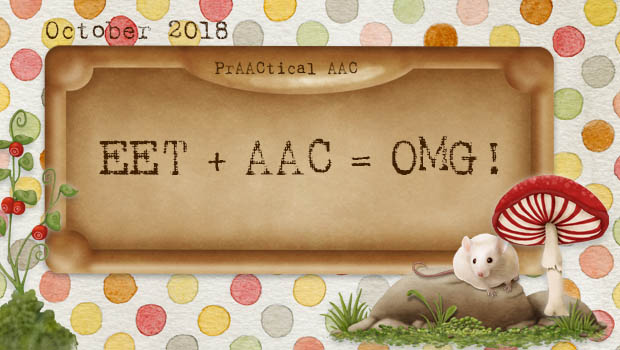
Supporting language development through well-planned intervention is a favorite topic here, and it is with pleasure that we feature Indiana-based SLP and ATP, Beth Waite-Lafever. Beth is a speech-language pathologist and has RESNA certification in Assistive Technology. She has worked in the field of AAC over the past 30 years in outpatient rehab, private practice, and public schools. Beth is a frequent presenter at national conferences, including ATIA and Closing The Gap, and teaches monthly online courses in implementation and use of speech generating devices. Currently, she is an SLP and Assistive Technology Coach for MSD Martinsville, a school district 30 miles south of Indianapolis and maintains a private practice. In this post, Beth shares her experiences in using the Expanding Expression Tool in language therapy with students who use AAC.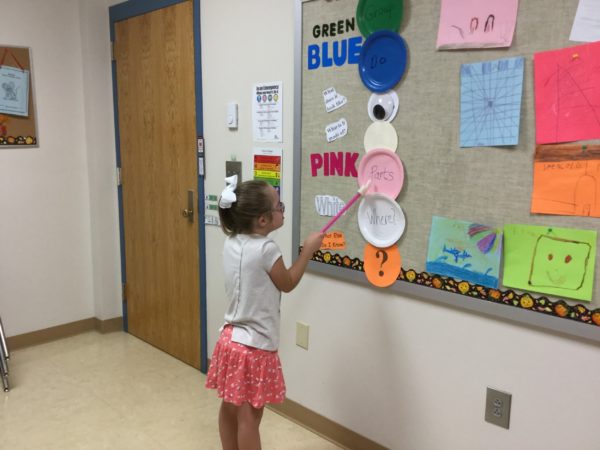
:::::::::::::::::::::::::::::::::::::::::::::::::::::::::::::::::::::::::::::::::::::::::::::::::::::::::
EET + AAC = OMG!
You may have heard of EET; Expanding Expression Tool, a multi-sensory strategy designed by speech-language pathologist Sara Smith, to improve oral language and writing. Developed for use to support academics, many schools use EET as a component of their early learning curriculum. It is a very visual strategy with color-coding used to help elicit language. EET was created to support academics by building oral and written language in the following areas:
- Oral expression
- Written expression
- Vocabulary comprehension
- Defining and describing
- Making associations
- Stating functions of objects
- Categorization
- Similarities and difference
But combine AAC with EET and Oh My Goodness…the results are amazing!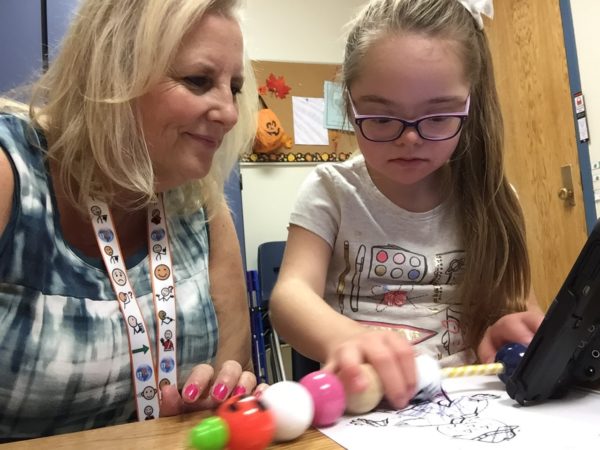
I’ve been using EET with many of my students using speech generating devices during the past 18 months with great results. Before I introduced EET, it was difficult to help my beginning communicators (ages 5 – 14) understand the concepts of categorization and associations, as well as use adjectives to describe items. Using visual data logging, we see not only their number of words grow, but also the different kinds of words they are using.
EET is a fun and engaging activity for individual or group therapy, as well as for push-in to the classroom. Having students who are more verbal provides great role models for those who communicate with AAC.
First, we learn the chant that represents the color-coded cues (Green Group, Blue Do, What Does It Look Like?, What Is It Made Of?, Pink Parts, White Where, and What Else Do I know?). For very early learners, we just focus on one component at a time at first, adding another component as their understanding grows. Our sessions begin with the chant, as well as review using the EET bulletin board in my room and the multi-sensory colored bead tool that comes with the kit. Students recall color words in their speech generating devices to participate in this activity. Then let the descriptive teaching begin! Using the components of EET are a super way to practice descriptive teaching. For example, this month we have been working on the word “pumpkin”. While looking at a real pumpkin and a plastic jack-o-lantern, we begin EET + AAC.
To build background knowledge, we watched a couple of short videos showing children in a pumpkin patch and then carving a pumpkin. Then we started our discussion.
Green Group: What group is a pumpkin in? If students have a difficult time starting with categorization, we move on to Blue Do, the actions with the item, and save the category until the end after we have described it. Some of my students were able to say “Halloween” as the group; others said, “food” or “toy”. All of those are correct.
Blue Do: What do we do with a pumpkin? After watching the videos, my AAC students used core words like “make”, “get”, “cut”, “eat” – again, all are correct. The main focus is that the students are using their words and thinking about all the different aspects of the target word.
What does it look like? The answers one young lady provided on her Accent 800 surprised me. She said “big, orange, moon, ball, circle”. She has been working on shapes and colors and it was so exciting to hear the language falling from her fingers!
What is it made of? This can be a tricky one for my students. We reviewed the video of a life cycle of a pumpkin and decided that the word “seed” was a good one to use for this part.
Pink Parts: Another interesting answer came here: Thinking “stem” would be a difficult word, and not really a core word, I modeled the word “top” for my student on her device. To my surprise, she then said “top off” on her speech generating device; after all, we had just watched someone carve a pumpkin in a video clip.
White Where: Where would you find a pumpkin? This can be another tricky question, so we talked about where you might buy a pumpkin and where you might find one, such as a store, or at home, or school.
What else do I know? One of my students used her device to say “fun” and “nice.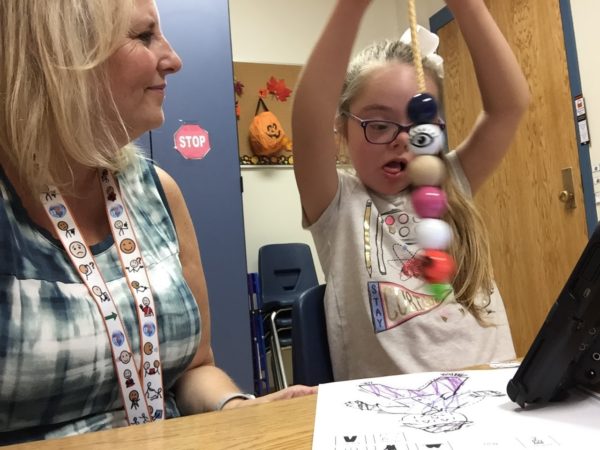
I prefer to change some of the questions (because it should be about conversation, not constant questioning) to think-aloud statements. Rather than using questions like “What is it made of?” or “What are the parts?”, I re-phrase these by saying “I wonder what it’s made of?” or “I’m trying to find out what parts it has?” Combining this with an expectant pause and modeling on an AAC system encourages students to make comments. Even if their comments aren’t correct, they’re learning skills like turn-taking and predicting. Often we investigate their guess by watching a video clip or through hands-on experiences.
It’s easy to build-in sensory components during language sessions. We throw bean bags or use a pointer to indicate the visual prompt on my EET bulletin board and students provide information about the target word based on what they hit/touch. Other times, we play a version of musical chairs by putting the visual prompts on the floor or in chairs and telling information about the target word based on which prompt we land on when the music stops.
Using EET with AAC is an awesome way to work on descriptive vocabulary and building phrases, as well as overall language development. Not only are we using core words to describe the vocabulary of the lesson but we are teaching the skill of using core words to describe words for future needs. The predictable chant naming the components, along with the visual prompts, has been a motivating way to introduce new vocabulary and expand parts of speech. My students are using more descriptive words and commenting in their daily communication on their speech generating devices. We’ve also seen an increase in utterance length. EET provides a fantastic visual framework for teaching language to students who communicate with AAC. For more information about EET, visit this site.
Filed under: Featured Posts, PrAACtical Thinking
Tagged With: Beth Waite, language therapy, narrative language
This post was written by Carole Zangari


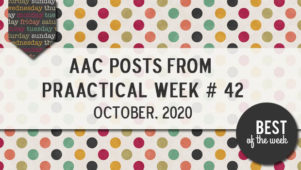

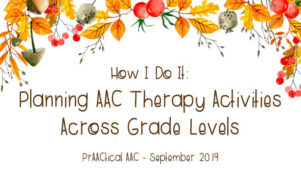
1 Comment
Thank you for this awesome way of using EET!! Where did you get that cool lanyard?!